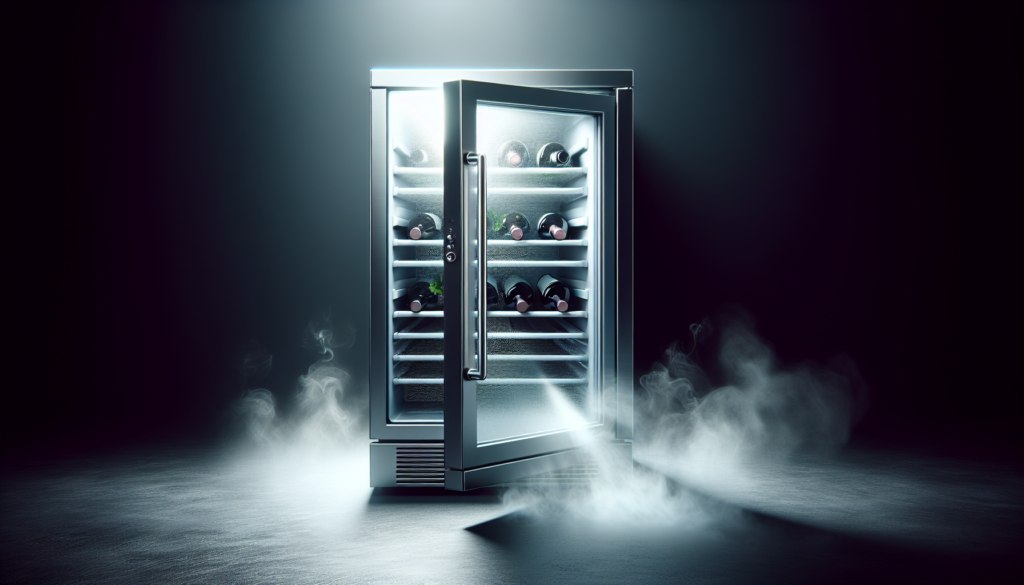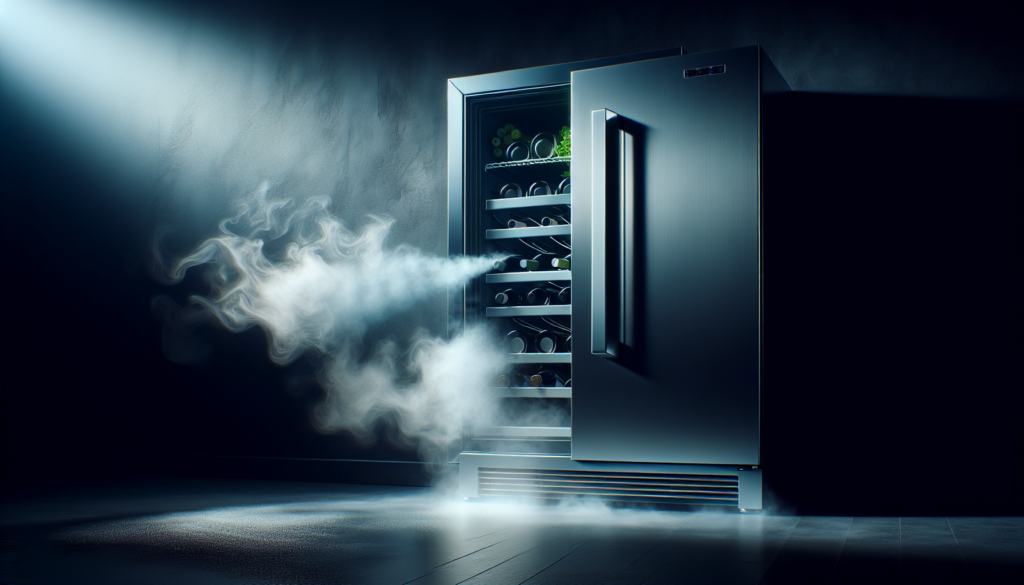Having a wine fridge is a true luxury, allowing you to store your favorite bottles at the perfect temperature. However, when your wine fridge stops cooling, it can be quite frustrating. Whether you’re a wine enthusiast or simply enjoy the occasional glass, a warm bottle of wine is far from ideal. But fear not! In this article, we’ll explore the common reasons why your wine fridge may not be cooling and provide you with some simple troubleshooting tips to get it back to its chilling best. No need to panic – we’ve got you covered!

Common Causes of Wine Fridge Not Cooling
1. Incorrect Temperature Settings
One common cause of a wine fridge not cooling properly is incorrect temperature settings. It’s important to ensure that the temperature settings are set to the appropriate level for storing wine. If the temperature is set too high or too low, it can impact the cooling efficiency of the fridge. Make sure to check the manufacturer’s instructions or the recommended temperature range for storing wine, and adjust the settings accordingly.
2. Insufficient Air Circulation
Another possible reason for a wine fridge not cooling is insufficient air circulation. The cooling process in a wine fridge relies on proper airflow to maintain the desired temperature. If the air circulation is restricted or blocked, it can lead to inadequate cooling. To address this issue, make sure that there is enough space around the fridge for air to flow freely. Avoid placing the fridge in a cramped area or against a wall. Additionally, ensure that the vents and fan inside the fridge are not blocked by any items.
3. Dirty Condenser Coils
Dirty condenser coils can also be a culprit behind a wine fridge not cooling properly. Over time, dust, dirt, and debris can build up on the condenser coils, affecting their ability to dissipate heat. When the coils become dirty, the fridge has to work harder to cool down, leading to poor cooling performance. To solve this issue, it’s essential to regularly clean the condenser coils. You can use a vacuum cleaner or a soft brush to remove any dirt or debris from the coils.
4. Faulty Thermostat
A faulty thermostat can be another reason why your wine fridge is not cooling as it should. The thermostat is responsible for regulating the temperature inside the fridge, and if it becomes damaged or malfunctioning, it may not accurately read or control the temperature. To troubleshoot this issue, you can try adjusting the temperature settings and observing if there is any change. If the fridge still fails to cool properly, it may be necessary to replace the thermostat.
5. Inadequate Power Supply
Sometimes, inadequate power supply can prevent a wine fridge from cooling effectively. If the fridge is not receiving enough power, it may struggle to cool down properly or maintain a consistent temperature. Check the power supply connection, ensure that the fridge is plugged into a dedicated electrical outlet, and confirm that the outlet is supplying enough power. If the issue persists, you may need to consult an electrician to assess the electrical system and make any necessary upgrades.
Troubleshooting Wine Fridge Not Cooling
1. Check Temperature Settings
If you’re experiencing problems with your wine fridge not cooling, the first troubleshooting step is to check the temperature settings. Ensure that the temperature is set within the recommended range for wine storage. It’s important to note that different types of wine require different temperature ranges, with most wines being best stored between 45-60°F (7-15°C). If the temperature setting is incorrect, adjust it accordingly and monitor if the cooling issue improves.
2. Ensure Proper Air Circulation
Make sure that your wine fridge has proper air circulation to optimize its cooling performance. Check for any obstructions or items placed too closely to the fridge that may hinder the flow of air. Additionally, ensure that the vents and fan inside the fridge are free from dust or debris. By allowing adequate air circulation, you can help the fridge cool more efficiently and maintain the desired temperature for your wine collection.
3. Clean Condenser Coils
Regularly cleaning the condenser coils of your wine fridge is essential to ensure its proper cooling function. Over time, dust and dirt can accumulate on the coils, insulating them and preventing efficient heat dissipation. This can lead to a decrease in cooling performance. To clean the coils, unplug the fridge and gently vacuum or brush away any dirt or debris. Be careful not to damage the coils in the process. Performing this maintenance task periodically can help prevent cooling issues and prolong the lifespan of your wine fridge.
4. Test the Thermostat
If the temperature setting seems correct but your wine fridge is still not cooling properly, it’s worth testing the thermostat. First, ensure that the fridge is receiving power and that the thermostat is turned on. Then, adjust the thermostat to a lower temperature setting and monitor if the cooling function is activated. If the fridge does not respond or fails to reach the desired temperature, there may be an issue with the thermostat. Consider consulting a professional technician to diagnose and repair the faulty thermostat.
5. Verify Power Supply
Inadequate power supply can sometimes be the cause of a wine fridge not cooling effectively. Ensure that the fridge is plugged into a dedicated electrical outlet and that the outlet is supplying enough power. Check if any fuses have blown or circuit breakers have tripped. If you suspect an issue with the power supply, it’s recommended to contact a licensed electrician to assess the electrical system and make any necessary repairs or upgrades.
When to Seek Professional Help
While some wine fridge cooling issues can be resolved through troubleshooting, there are certain situations where it’s best to seek professional help.
1. Continuously Warm Temperature
If your wine fridge consistently fails to cool down to the desired temperature, even after trying various troubleshooting steps, it may indicate a more significant problem. In such cases, it’s advisable to contact a professional technician who specializes in wine fridge repairs. They will have the expertise and tools to diagnose and address any underlying issues that may be causing the continuous warm temperature.
2. Unusual Noises or Vibrations
Unusual noises or vibrations coming from your wine fridge can be an indication of a mechanical or internal problem. If you notice any strange sounds, such as grinding, clicking, or buzzing, or if the fridge is vibrating excessively, it’s recommended to seek professional assistance. These symptoms may suggest issues with the compressor, motor, or other components of the fridge that require expert attention.
3. Frequent Cycling On and Off
If your wine fridge is cycling on and off frequently, it may be a sign of a malfunctioning component. The fridge should run consistently to maintain a stable temperature for optimal wine storage. When it cycles on and off too frequently, it can result in temperature fluctuations that can be detrimental to your wine collection. To prevent any potential damage, it’s best to have a professional technician examine the fridge and diagnose the cause of the frequent cycling.
Preventing Wine Fridge Cooling Issues
Taking preventive measures can help avoid common cooling issues with your wine fridge and ensure its longevity. Here are some tips to keep in mind:
1. Regular Maintenance
Performing regular maintenance tasks can significantly contribute to the cooling efficiency of your wine fridge. Clean the condenser coils periodically to prevent dust buildup, inspect the gaskets and seals for any signs of wear or damage, and ensure that the internal components are clean and functioning properly. Additionally, refer to the manufacturer’s guidelines for any specific maintenance instructions or recommendations.
2. Proper Placement
Proper placement of your wine fridge is crucial for its cooling performance. Avoid placing the fridge near heat sources such as direct sunlight, stoves, or heaters, as it can affect its ability to cool down effectively. Temperature extremes can also impact the fridge’s performance, so choose a location with a stable ambient temperature. Additionally, make sure that the fridge is level to prevent any potential cooling issues.
3. Adequate Ventilation
Ensure that there is adequate ventilation around your wine fridge to promote proper airflow. Avoid placing the fridge in a tight space or against a wall, as it can restrict the flow of air and hinder the cooling process. Give the fridge enough room to breathe, allowing for free circulation of air. This will help maintain a consistent temperature inside the fridge and optimize its cooling capabilities.
By following these preventive measures, you can minimize the risk of cooling issues and ensure that your wine fridge continues to cool your precious wine collection efficiently. Remember to consult the manufacturer’s guidelines for any specific instructions and reach out to professional technicians for any complex repairs or maintenance tasks. Cheers to enjoying perfectly chilled wines!

